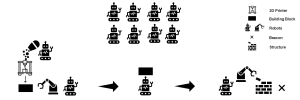project09:2024Msc2JIP: Difference between revisions
JIPStudent (talk | contribs) |
JIPStudent (talk | contribs) |
||
| Line 24: | Line 24: | ||
[[File:Con_ops.png|center|thumb|Concept of Operations of the project]] | [[File:Con_ops.png|center|thumb|Concept of Operations of the project]] | ||
==''' | =='''KEY TECHNOLOGIES '''== | ||
=== BUILDING BLOCKS === | |||
=== 3D PRINTING === | |||
=== SWARM ROBOTICS === | |||
=='''FINAL REVIEW '''== | =='''FINAL REVIEW '''== | ||
Revision as of 15:37, 14 November 2024
MSc 2 JIP Space Architecture & Infrastructure
The Lunar Constructors project is aimed at addressing one of the most pressing challenges in space exploration: creating sustainable, autonomous habitats on the lunar surface. As space agencies and private companies advance their capabilities for lunar missions, the goal of establishing long-term human presence on the Moon is becoming more tangible. However, the Moon's environment presents extreme challenges—including intense radiation, a lack of atmosphere, severe temperature fluctuations, and the impact of micrometeorites—that make traditional human-centric construction methods risky and complex.
The project addresses these challenges by proposing an autonomous, modular system for constructing lunar habitats, utilizing local resources and advanced robotic and manufacturing technologies. The project's approach combines three key technological domains:
- Swarm Robotics: Employing a decentralized system of robots that work collaboratively, each robot is designed to perform specific tasks, such as regolith collection, transportation, and assembly. Inspired by swarm intelligence, this autonomous approach allows a large number of small robots to adapt dynamically, perform tasks collectively, and compensate for any individual failures—critical attributes for construction in the harsh lunar environment.
- In-Situ Resource Utilization (ISRU): By harnessing the Moon's abundant surface material, known as lunar regolith, the project significantly reduces the need to transport construction materials from Earth. Lunar regolith is processed into durable building blocks, allowing habitat structures to be manufactured on-site. This approach aligns with sustainability goals and makes long-term missions more economically feasible.
- 3D Printing: Additive manufacturing methods, specifically adapted for lunar conditions, are used to transform regolith into interlocking building blocks. Techniques such as binder jetting and selective laser sintering allow the creation of complex structures that are lightweight yet resilient, accommodating the Moon's low gravity and atmospheric conditions.
The Lunar Constructors project tries to address the feasibility of lunar construction through a series of targeted objectives. This includes researching future robust 3D printing processes using lunar regolith simulants, designing efficient robot interactions for swarm-based construction, and simulating the assembly of various structures within the Gazebo simulation environment. The project also evaluates potential building designs, such as pyramidal and dome-shaped structures, which are suited to the lunar environment's unique demands.
By leveraging advanced autonomous systems and local materials, Lunar Constructors aims to contribute significantly to global efforts in space exploration. This project offers a scalable, sustainable approach to lunar habitat construction, helping to pave the way for future missions and long-term human presence on the Moon.
Problem Statement
The project aims to perform a feasibility study of setting up a structure on the surface of the Moon by using in-situ resources to 3D print the structure and assembling it using a swarm of robots.
Concept of Operations
A general concept of operations was developed to have a clear perspective of the mission. Figure 1 illustrates the concept of operations of the Lunar Constructors project. As illustrated in the figure, from the swarm of robots available, one of the robots collects lunar regolith, which is fed to a 3D printer to produce blocks for the structure. The blocks are then transported to a site by the robots, where they use their swarm intelligence to build a structure using a predefined rule set.

KEY TECHNOLOGIES
BUILDING BLOCKS
3D PRINTING
SWARM ROBOTICS
FINAL REVIEW